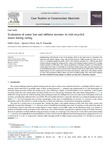Mostrar o rexistro simple do ítem
Evaluation of water loss and stiffness increase in cold recycled mixes during curing
| dc.contributor.author | Orosa, Pablo | |
| dc.contributor.author | Pérez Pérez, Ignacio | |
| dc.contributor.author | Pasandín, A.R. | |
| dc.date.accessioned | 2023-05-02T15:26:30Z | |
| dc.date.available | 2023-05-02T15:26:30Z | |
| dc.date.issued | 2023 | |
| dc.identifier.citation | Orosa, P., Pérez, I., Pasandín, A. R. (2023). Evaluation of water loss and stiffness increase in cold recycled mixes during curing. Case Studies in Construction Materials, e01877. https://doi.org/10.1016/j.cscm.2023.e01877 | es_ES |
| dc.identifier.uri | http://hdl.handle.net/2183/32969 | |
| dc.description | Financiado para publicación en acceso aberto: Universidade da Coruña/CISUG | es_ES |
| dc.description.abstract | [Abstract:] Implementing cold solutions is one of the primary efforts in the road sector to counteract CO2 emissions and climate change. Using cold recycled mixtures (CRM) permits the reuse of up to 100% of reclaimed asphalt pavement (RAP). This research examines how CRM develop their resilient response during the curing process. Using cyclic loading dynamic triaxial (DTx) testing, resilient moduli of CRM made with various proportions of bitumen emulsion were determined. Curing times from 0 days to 18 months were assessed. Binder content and water loss speed proved to be fundamental factors in the evolution of the resilient moduli of the CRM studied. CRM with a binder content of 2.50% exhibited the best short-term response, while those with a binder content of 3.00% showed greater stiffness values over more extended curing. Once water losses stopped, the CRM continued showing changes in stiffness, proving their evolutionary response. | es_ES |
| dc.description.sponsorship | The authors would like to acknowledge the funding for the project BIA2016–80317-R/AEI/10.13039/501100011033 from the Spanish Ministry of Science and Innovation, with an associated pre-doctoral scholarship for the training of research workers (FPI) BES-2017-079633. The authors would also like to express their sincere gratitude to ARIAS INFRAESTRUCTURAS and ECOASFALT for their generous donation of RAP and bitumen emulsion, respectively, for the present research. An special acknowledgement to the Universidade da Coruña/ CISUG for funding part of the Elsevier's open acces charge. Finally, the corresponding author expresses his gratitude to Natalia Pérez-Barge, and Jorge del Valle Corte for their help and support during the laboratory works, and to Marina G. López-Arias for her help with the analysis of the results. | es_ES |
| dc.description.sponsorship | Ministerio de Economía, Industria y Competitividad; BIA2016-80317-R | es_ES |
| dc.language.iso | eng | es_ES |
| dc.publisher | Elsevier | es_ES |
| dc.relation | info:eu-repo/grantAgreement/AEI/Plan Estatal de Investigación Científica y Técnica y de Innovación 2017-2020/BES-2017-079633 | es_ES |
| dc.relation.uri | https://doi.org/10.1016/j.cscm.2023.e01877 | es_ES |
| dc.rights | Atribución 3.0 España | es_ES |
| dc.rights.uri | http://creativecommons.org/licenses/by/3.0/es/ | * |
| dc.subject | Cold recycled mixtures (CRM) | es_ES |
| dc.subject | Reclaimed asphalt pavement (RAP) | es_ES |
| dc.subject | Bitumen emulsion | es_ES |
| dc.subject | Triaxial testing | es_ES |
| dc.subject | Nonlinear elastic behavior | es_ES |
| dc.subject | Curing | es_ES |
| dc.title | Evaluation of water loss and stiffness increase in cold recycled mixes during curing | es_ES |
| dc.type | info:eu-repo/semantics/article | es_ES |
| dc.rights.access | info:eu-repo/semantics/openAccess | es_ES |
| UDC.journalTitle | Case Studies in Construction Materials | es_ES |
| UDC.volume | 18 | es_ES |
| UDC.startPage | e01877 | es_ES |
| dc.identifier.doi | 10.1016/j.cscm.2023.e01877 |
Ficheiros no ítem
Este ítem aparece na(s) seguinte(s) colección(s)
-
CITEEC-CGM - Artigos [93]






